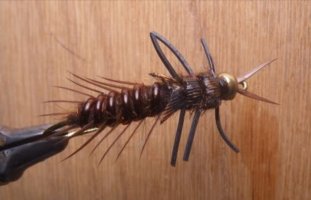jar546
CBO
When I was a kid, summers meant fishing trips with my grandfather and uncle along the Susquehanna River near Tunkhannock, Pennsylvania. After losing my father in a car accident just before I turned three, my grandfather—my dad’s dad—and my uncle—his brother—stepped in to teach me the ropes. Those fishing trips weren’t just about catching fish; they were about building a connection that bridged the gap left by my father’s absence.
Our bait of choice for catching smallmouth bass was something my grandfather called “clippers.” We’d head to a rural part of the river where the water was clearer and shallower. We’d wade in with sneakers on, shorts rolled up, and the current swirling around our waists. If my mother knew what we were doing, she would’ve had a fit, but that was part of the fun—it was our little secret.
Catching clippers was a skill. My grandfather would flip rocks over, and we’d face upstream, ready to catch these critters as they were swept away by the current. I didn’t know it then, but these “clippers” were actually hellgrammites—the larval stage of the Dobsonfly.
Hellgrammites are fascinating creatures. They spend up to five years in the river as larvae before transforming into the winged Dobsonfly. They thrive in clean, oxygen-rich water, which is why we always found them in those pristine stretches of the Susquehanna. Hellgrammites have long, segmented bodies, strong mandibles, and can grow up to 3 inches long. They’re tough, predatory, and make incredibly effective bait for smallmouth bass, which can’t seem to resist their wriggling.
The life cycle of a hellgrammite is as intriguing as the creature itself. After spending years as larvae in the water, they eventually crawl onto land, where they pupate and transform into adult Dobsonflies. The adult stage is short-lived—just a few days to a week—focused solely on reproduction. But it’s during those long years as a hellgrammite that they become the prized bait my grandfather and uncle taught me to catch.
Those fishing trips were more than just outings; they were lessons in patience, resilience, and connection to the natural world. Standing in the river with my grandfather and uncle, feeling the pull of the current and the thrill of a fish on the line, I felt a connection to my father that’s hard to describe.
Looking back, I realize how much those days shaped me. The lessons I learned in that river—respect for nature, the value of persistence—are things I carry with me to this day. And while I might not fish as often as I used to, the memories of those clippers, and the time spent with my grandfather and uncle, are with me always.
So, if you ever find yourself by a river, take a moment to flip a rock or two. You might find a clipper, and with it, a connection to simpler times and the people who made them special. Share this with anyone who appreciates the simple joys of life, the bonds of family, and the timeless tradition of fishing along the Susquehanna River.

Our bait of choice for catching smallmouth bass was something my grandfather called “clippers.” We’d head to a rural part of the river where the water was clearer and shallower. We’d wade in with sneakers on, shorts rolled up, and the current swirling around our waists. If my mother knew what we were doing, she would’ve had a fit, but that was part of the fun—it was our little secret.
Catching clippers was a skill. My grandfather would flip rocks over, and we’d face upstream, ready to catch these critters as they were swept away by the current. I didn’t know it then, but these “clippers” were actually hellgrammites—the larval stage of the Dobsonfly.
Hellgrammites are fascinating creatures. They spend up to five years in the river as larvae before transforming into the winged Dobsonfly. They thrive in clean, oxygen-rich water, which is why we always found them in those pristine stretches of the Susquehanna. Hellgrammites have long, segmented bodies, strong mandibles, and can grow up to 3 inches long. They’re tough, predatory, and make incredibly effective bait for smallmouth bass, which can’t seem to resist their wriggling.
The life cycle of a hellgrammite is as intriguing as the creature itself. After spending years as larvae in the water, they eventually crawl onto land, where they pupate and transform into adult Dobsonflies. The adult stage is short-lived—just a few days to a week—focused solely on reproduction. But it’s during those long years as a hellgrammite that they become the prized bait my grandfather and uncle taught me to catch.
Those fishing trips were more than just outings; they were lessons in patience, resilience, and connection to the natural world. Standing in the river with my grandfather and uncle, feeling the pull of the current and the thrill of a fish on the line, I felt a connection to my father that’s hard to describe.
Looking back, I realize how much those days shaped me. The lessons I learned in that river—respect for nature, the value of persistence—are things I carry with me to this day. And while I might not fish as often as I used to, the memories of those clippers, and the time spent with my grandfather and uncle, are with me always.
So, if you ever find yourself by a river, take a moment to flip a rock or two. You might find a clipper, and with it, a connection to simpler times and the people who made them special. Share this with anyone who appreciates the simple joys of life, the bonds of family, and the timeless tradition of fishing along the Susquehanna River.


